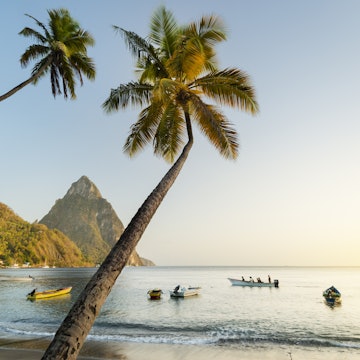

Santa Maria in Portugal's Azores islands. Sammi Chaves/Shutterstock
When you first look through the airplane window and down at the Azores, you might think you’re in the South Pacific. Just a quick glimpse will explain why so many call this Portuguese archipelago the “Hawaii of Europe” and the “Islands of Colors.”
Set in the middle of the Atlantic halfway between the US and continental Portugal, the nine major Azores islands – São Miguel, Santa Maria, Terceira, Graciosa, São Jorge, Pico, Faial, Flores and Corvo – are impossible not to adore.
Expect green fields spotted with free-roaming local cattle (referred to locally as “happy cows”) and lagoons in extinct volcanoes. Thermal pools offer the chance for a hot dip (the warmth coming from deep within the earth), while ultra-fresh ingredients make for uniquely savory local cuisine.
A trip to the Azores is simply a must-do for savvy travelers – and one you’ll never forget. If you’ve never been before, read on. Then get planning.

When should I go to the Azores?
Since the Azores are a year-round destination, your key considerations will be activities and budget. The summer brings many visitors from the mainland who arrive to soak up the scenery or visit relatives, making this a busier and more expensive season.
The scene is more relaxed and cheaper in the shoulder seasons, while winter can offer challenging weather. Remember that the islands are set in the middle of the ocean and are more exposed to winter storms that form in the Atlantic – which often affects flights (and your plans!).
Whenever you visit, prepare to face all four seasons in one day. You can wake up with sunshine and warm weather only to hike up a mountain and find plunging temperatures, lashing rain and minimal visibility. Don’t leave without packing a waterproof layer to keep stored in your backpack at all times.
In the summer, temperatures range from about 20°C to 26°C (68°F to 79°F), in the shoulder seasons from about 15.5°C to 22°C (60°F to 71°F), and during winter from about 12°C to 18°C (53°F to 64°F). Keep in mind that temperatures can vary widely at different spots on these remote islands.
Is it easy to get to the Azores?
São Miguel is the largest island in the Azores and works as a hub to reach the other eight. The Ponta Delgada airport receives international flights from the US and Canada, as well as a number of European countries; transatlantic flights also serve Terceira. If you can’t find a nonstop flight, the easiest way to get to the Azores is via Lisbon or Porto on Portugal’s mainland.
From São Miguel, you can get internal flights with the local airline SATA to every island in the Azores. You can also opt for SATA’s Azores Air Pass, which allows travelers to visit up to three islands at a special rate. Another way to get around is by ferry: Atlânticoline serves Terceira, Graciosa, São Jorge, Pico, Faial, Flores and Corvo.
Be advised that your plane or boat legs may change, as the departure schedule can be disrupted by air and ocean conditions. Being flexible with your itinerary is a good idea if you plan to visit more than one island in the Azores, especially in wintertime.

Is it easy to get around the Azores?
Renting a car is the best way to explore these beautiful islands. With so much to see and do, having the freedom to travel at your own pace and visit more off-the-beaten-track locations is essential to making the most of your trip. Plus, renting a car allows you to easily get around the larger islands, such as São Miguel (743 sq km/287 sq miles), Pico (445 sq km/172 sq miles) or Terceira (399 sq km/154 sq miles).

Meet your new travel partner
Unlimited data while you travel with Holafly eSIM. Use code LONELYPLANET for an exclusive discount.
You can even take your rented car on the ferry between some of the islands, including the Pico–Faial–São Jorge triangle. Public buses are also available on all islands except Corvo.
Once you reach your desired destination, get out and explore on foot; the views in these islands never disappoint. Walk the dirt paths, immerse yourself in nature and be amazed by the sounds of birds, running waterfalls, and the smell of flowers and wet vegetation.

How much time should I spend in the Azores?
It all depends on what you want to do. São Miguel is a great option for first-time visitors, with its wide range of activities, landscapes, and great restaurant and accommodation options. Five days should be enough time for a thorough introduction.
But if you want to get a true sense of the richness of the Azores, set aside two to three weeks to hop between islands and get to know what distinguishes each one – and why the archipelago is truly one of the most exceptional destinations in Europe.

Top things to do in the Azores
Hike for days
If you want to immerse yourself in nature and experience the rawness of gorgeous landscapes, you’re in luck. All the islands have hiking trails that bring you deep into their wild heart, revealing lagoons formed inside extinct volcanoes or waterfalls that cascade from the tops of mountains.
On the island of the same name, Mt Pico is another must-see place in the Azores. As the highest point in Portugal, it’s a challenging climb. But the unforgettable view from the top on a clear day is well worth the effort.
While in Pico, visit the local vineyards that are part of a landscape that’s been declared a UNESCO World Heritage site. Gaze out at the ocean as you enjoy a glass of wine: you might spot a pod of playful dolphins or even giant whales.


Explore how volcanoes have shaped the islands’ landscape and history
You’ll know you’re atop a cluster of volcanoes when you see the dark-gray stone used in old buildings, and black sand on the beaches. When visiting São Miguel, you can even feel the volcanic activity on your skin: the water at iron-rich thermal springs is warmed by heat emanating from the island’s inner depths.
That same heat cooks the traditional cozido dos Açores (Azorean stew) in the Furnas area, where chefs place vegetables and meat in the earth for up to seven hours, before it emerges steaming hot and with a sulfur-y kick. Terceira and São Jorge also have natural pools that are carved in stone by the rough Atlantic and simultaneously heated by volcanic rock.
In Faial, the underwater Vulcão dos Capelinhos erupted in the 1950s – an event that caused half of the island’s population to flee. An interpretative center near the eruption's site gives context about ongoing volcanic activity in and around the islands.

Combine a whale-watching trip with a visit to a tea factory
Exploring outdoors is far from the only activity in the Azores. On São Miguel, you can join a whale-watching cruise, visit cheese factories, see spiky fruit grow at pineapple plantations or spend an hour or two at the famous Gorreana Tea Factory, the oldest (and arguably only) tea plantation in Europe. Staff members offer free tours of the factory and museum, which feature plenty of vintage machinery (some still in use); toast to your visit with a cup at the end of the tour.

My favorite thing to do in the Azores
If your goal is to escape and disconnect from the world, you’ll find that tranquility in the Azorean fajãs, small coastal villages next to large cliffs.
I recommend the difficult-to-access but enchanting Fajã da Caldeira de Santo Cristo on São Jorge. You can get there on foot by following the Caldeira de Santo Cristo Trail, which starts in Serra do Topo. The descent gradually reveals the small town, its houses, the church and a large lagoon stretching near the sea. You can also arrive by quad bike, starting from Fajã dos Cubres; pre-arrange the trip with your accommodation.
Once in Fajã de Santo Cristo, cell phone and internet connections are almost non-existent, leaving no choice but to unplug and slow down. This is the ideal place to relax, catch up on your reading, discover the lagoon by kayak or taste the clams served at O Borges, the oldest restaurant in this location.
How much money do I need in the Azores?
The Azores are a destination for all types of travelers, with everything from five-star hotels to local homestays. You can find lodging, food options and island tours to suit all budgets. Car rental will likely be your biggest expense, especially if you are traveling in high season; try to plan ahead and make reservations as early as possible.
These are the average daily costs you can expect:
Four-star hotel room for two: from €150 (US$171)
Dormitory room in a hostel: from €45 (US$51)
Self-catering apartment: from €100 (US$114)
Car rental: from €35 (US$40) per day for a small car
Furnas stew for two: €30 (US$34)
Coffee: €1 (US$1.15)
Beer: €1.50 (US$1.70)
Entrance to hot springs: €8 (US$9)

What should I pack when visiting the Azores?
Given the variable weather and outdoor adventure possibilities in the Azores, be sure to bring a light rain jacket, a breathable fleece layer you can take on and off on the go, and waterproof trekking boots and poles. You’ll want a good backpack to carry all of this with you as you get out and about in this magical archipelago.
Remember to interact with nature safely
Exploring the various volcanic craters and lagoons hidden in the islands’ interiors is one of the Azores’ most memorable experiences. Keep in mind that these extraordinary natural ecosystems should be approached with great care.
Respect the local landscape by visiting in a way that doesn’t disturb animals or damage any plants; the easiest way to do this is by sticking to marked trails. Many are there to protect vegetation and prevent soil erosion but also exist for your safety, as they avoid unstable or slippery ground.
Also, as much as the lagoons seem like the perfect opportunity for a cooling dip, most are unsuitable for bathing or swimming for safety reasons. Always follow the safety signs displayed at each lagoon.
Finally, be aware that weather conditions can change from one moment to the next, especially in higher areas. Check the forecast before venturing out on a long trail to ensure you’re not caught in a precarious position mid-hike. And never forget that waterproof layer.
















